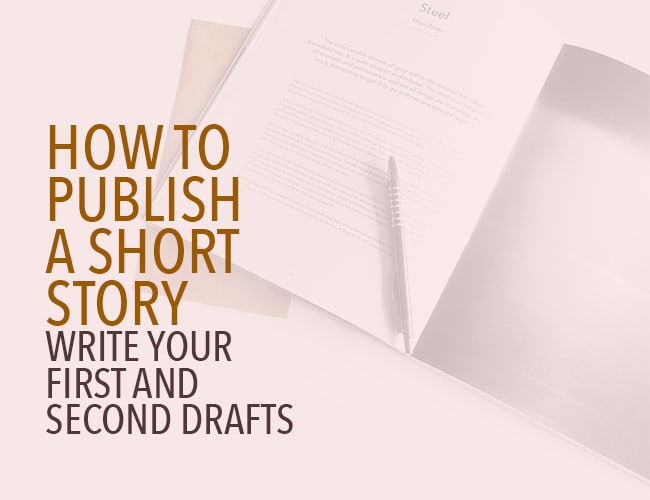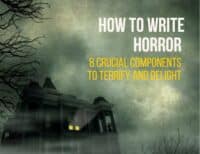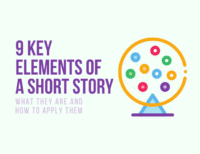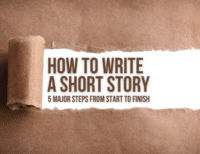Two weeks ago, I urged you to come on a publication journey with me, one where I walk you through the process of planning, writing, and submitting a short story. This is the second post in the four-part series on how to publish a short story. By the end, you’ll have a story ready to send out to publications!

If you’re a little late to the party, never fear! You can still participate. Look back at the first two steps and then join me back here.
This week, we’re going to concentrate on writing and the first edit.
NOTE: Throughout this series, DO NOT post your work in the comments. I’m going to ask you to submit to a publisher at the end of this series, and posting it here would be considered publishing it. Our Becoming Writer community is a great place to workshop your story before you submit it.
Writing Your Story
By now, you should have a publication in mind and have the answers to a couple basic questions. Maybe you brainstormed or did a full outline. Bonus points if you’ve got a draft! (But don’t worry if you don’t.)
Now pick up the pen and write the thing!
This series is focused on how to submit stories and isn't meant to be a masterclass in short story writing, but I’ve tried to include as many basics as I can. For further information on writing shorts, check this out.
If you’ve got a draft already, this post will still be useful to you, so don’t skip reading it!
3. First Draft: Write in One Sitting
Smile. This is the fun part.
Short stories are meant to be consumed in a single sitting, so it makes sense to write them in one. This isn't as daunting as it seems. You'll find your enthusiasm will drive you to the end and the story will flow much better.
Sit down and write. Write quickly. Write badly. Just write.
This is not the time to worry about your word count. Wait, what? I know. I told you to pick out a publication and they’ve given you a word count to stick to. Ignore that for the moment.
Right now, your job is to tell your story. The story will let you know when it’s finished. Overwriting is fine, and actually encouraged, at this stage. On the opposite end, if you’re lacking in words, that’s okay, too. You can always fill in more description later.
For now, just let it flow.
But do remember the four questions I gave you the last time and keep them in mind as a roadmap for going forward. Don’t worry if you get a little lost or off-track. Sometimes stories insist on a life of their own. Don’t panic. That’s normal.
4. Break Time
When you’ve written the last word and are riding that rush of excitement, I need you to do something vitally important: TAKE A BREAK! This is so important, I've included it as one of the steps instead of simply mentioning it in passing.
Put the story away and out of your mind. I recommend a three-day hiatus at this stage. That’s just enough for you to forget what you wrote and why you wrote it that way, but not enough time to lose interest in the story.
Don’t look at it. Don’t edit it. Don’t even think about it.
Read a book, get some sleep, or work on another story. Fight the urge to edit right away!
5. Second Draft: Get Critical
This is the less fun but crucial part. Your first draft is not perfect.
Say it with me now: MY FIRST DRAFT IS NOT PERFECT!
You’ve had a break and hopefully you've forgotten why you loved this specific turn of phrase or that overlong description. Now you’re going to get brutal. You’re going to cut, add, and rearrange with all the mercy of a general on a battlefield.
First things first: Make sure your story is a story! This might sound obvious, but sometimes it’s not.
When I first started writing shorts, it was all nonsense. Halfway decent prose, but utter nonsense. There was no point. There was no character development. There was no climax. It took a long time for me to realize I was getting rejected because I hadn’t written a story.
A short is different from a novel. You don’t have time to ramble. But a short story is still a story and needs to read like one. It must contain all the elements I mentioned mine lacked. And it must have a beginning, middle, and end.
Here are a few short story fundamentals to achieve that goal:
Elements of a Short Story: What Should Be
- Start with action: No overly complicated scene setting or a ton of character inner musings needed. Get the story moving.
- Show, don’t tell: Telling seems like a good way to get to the point, right? Nope. A short story is still a story, not a sequence of events spat out in synopsis form by a robot. This happens, then this happens, and finally this happens, is an outline, not a narrative.
- Good pacing: Good shorts don’t spend too much time on description and rush through the action. They flow well from one scene to the next and none of those scenes are unnecessary.
- Climax and efficient build up to it: Every single word in a short story needs to drive the reader to the climax. Move toward that climax efficiently. If there’s something that doesn’t serve this purpose, chop it. And make sure your climax is in there!
- Satisfying resolution: Your ending must wrap up your story. It needs to be clear, there can be a twist or surprise (but make sure that surprise isn’t coming out of nowhere), and there needs to be a change from the way things were in the beginning.
Common Short Story Mistakes: What Shouldn’t Be
- Overcomplicated plot: Again, keep it simple. Shorts revolve around one central theme, action, upheaval, or event. If you’ve got a bunch of B plots, your story probably isn’t suited for the structure of a short.
- Too much backstory and world-building: Only tell us what we need to know, when we need to know it. You can know every little detail about your character’s third-grade experience or the ecosystem of your fictional planet, but is it necessary for your reader to know? This is a general rule when writing, but especially so for shorts. You don’t have the space to tell us everything. Stick to the point.
- Bad dialogue: This is one of the things I see the most with short stories. One way to fix this is to read your dialogue aloud, preferably with a partner. If it sounds funny coming out of your mouth, it’s not right. Remember, people rarely use another person’s name when talking to them and contractions are your friend.
- Head hopping: Stay in one point of view. There’s not enough time or space in a short to skip around.
- Abrupt ending: Make sure you haven’t just cut off your story to stay in the word count. (The climax is not the ending!) Take us all the way through.
Write, Write, Write!
For the next two weeks, concentrate on getting through the first and second drafts using the tips above. This might get frustrating at points. You may want to give up. Don’t. You’ll get through it.
And most importantly: Your writing DOES NOT suck! (We all need that little reminder now and then.)
Still wondering how to publish a short story? Don't worry. In the next post, I’ll go over getting feedback and the nitpicky edits of the third draft. Soon, your story will be publication ready!
Which short story elements do you think you do the best? Which do you think you need to work on? Let me know in the comments.
PRACTICE
You guessed it: Today you’re writing your story. Take fifteen minutes to work on it. Let it flow. Write as much as you can in that time. If you’re on a roll when your time is up, keep going!
When you’re finished, come back here and tell me how much you wrote. How do you feel? Was it a hard writing day or did your pen fly across the page? (Remember: Don’t post your story in the comments! You can share it in our Becoming Writer community instead.)
Don’t forget to jump in the comments and offer some encouragement to your fellow writers!







0 Comments
Trackbacks/Pingbacks